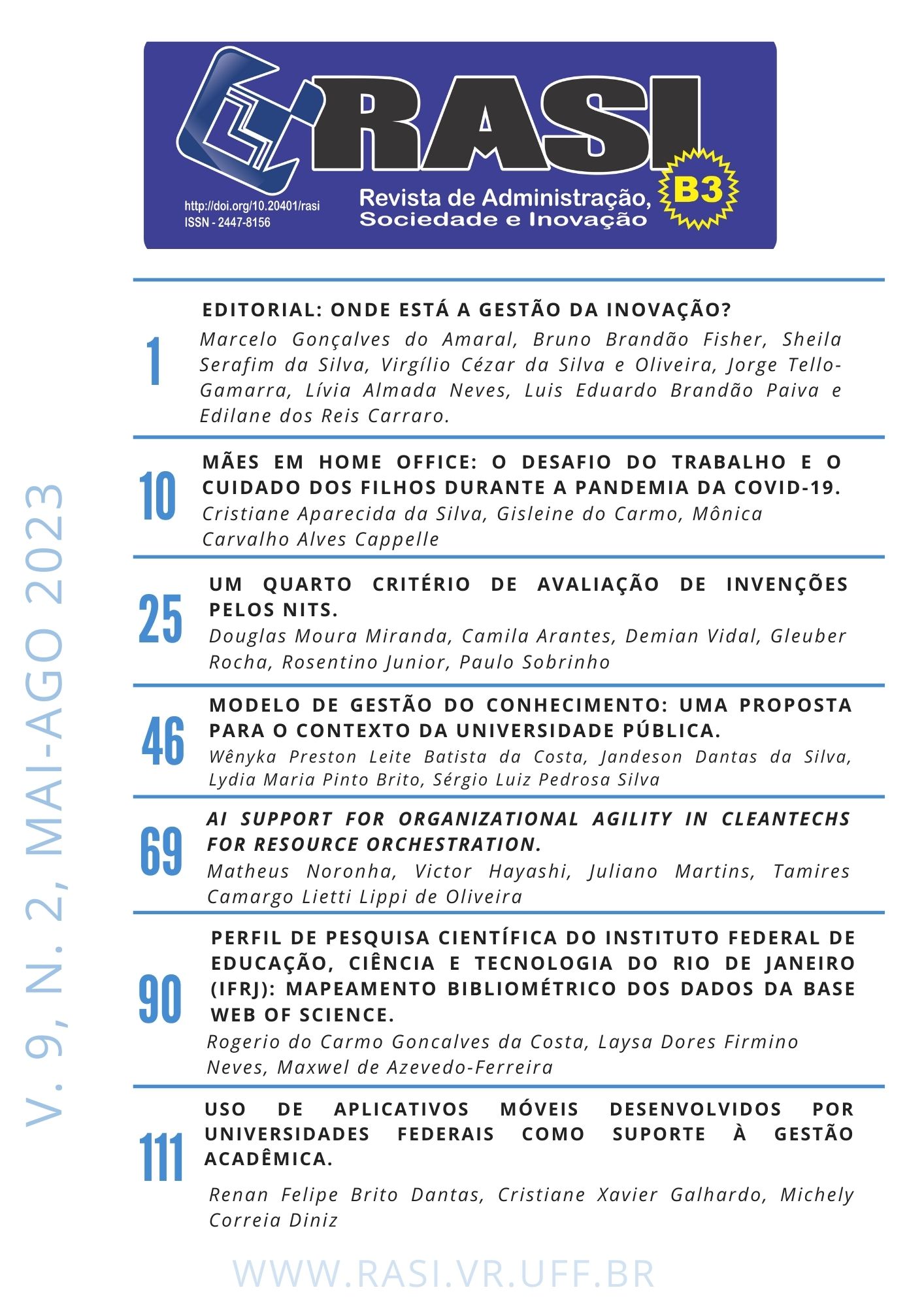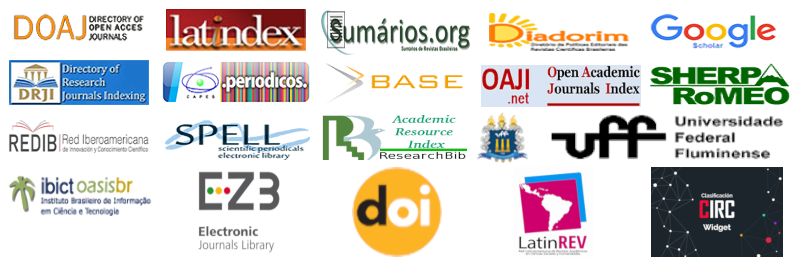O suporte da IA na Agilidade Organizacional em Cleantechs para Orquestração de Recursos
DOI:
https://doi.org/10.20401/rasi.9.2.733Keywords:
Inteligência Artificial, Agilidade Organizacional, Orquestração de Recursos, Cleantechs, Objetivos de Desenvolvimento SustentávelAbstract
O ambiente de negócios se aproxima do uso de tecnologias para ampliar sua faixa de competitividade no mercado. Estudos demonstram por meio da Inteligência Artificial novos caminhos competitivos e como estes podem orquestrar recursos tecnologicamente sustentáveis. Este artigo tem como objetivo apresentar um modelo de proposição que identifique como a IA potencializa a Agilidade Organizacional (AO) para a Orquestração de Recursos (OR) no contexto de empresas de tecnologia limpa e objetivos de desenvolvimento sustentável (ODS). Foi realizada uma pesquisa qualitativa, estudo de caso múltiplo, com 22 entrevistas semiestruturadas de 11 empresas de tecnologia limpa nas áreas de energia renovável, comercialização de energia, eficiência energética, saneamento e tratamento de água. A análise de conteúdo foi utilizada para análise dos dados. A IA incentiva a AO para a OR, apontando também novas categorias (achados) como: Tecnologia e Competências Digitais, Dinâmica de Sistemas e Acurácia para o desenvolvimento de produtos e serviços inovadores em Cleantechs. Este estudo contribui para a literatura com um novo modelo de IA e AO, Orquestrando Recursos por meio de Competências Digitais e Tecnológicas, proporcionando Dinâmica entre Sistemas de Aprendizagem e Acurácia para o desenvolvimento de produtos e serviços que visam colaborar com os ODS. Ilustrar os caminhos estratégicos que a IA pode tomar na perspectiva do Machine Learning para abordar soluções para os setores de energia e saneamento, proporcionando inovações. A originalidade do trabalho reside na articulação contextual do trabalho entre IA, AO e OR no contexto de empresas de tecnologia limpa e ODS.
Downloads
References
Ahuja, S., & Chan, Y. E. (2017). Resource orchestration for IT-enabled innovation. Kindai management review, 5(1), 78-96.
Carnes, C. M, Hitt, M. A., & Xu, K.,(2016). Resource based theory in operations management research. Journal of Operations Management, 41, 77-94.
Carnes, C. M., Chirico, F., Hitt, M. A., Huh, D. W., & Pisano, V. (2017). Resource orchestration for innovation: Structuring and bundling resources in growth-and maturity-stage firms. Long range planning, 50(4), 472-486.
Delmestri, G., Montanari, F., & Usai, A. (2005). Reputation and Strength of Ties in Predicting Commercial Success and Artistic Merit of Independents in the Italian Feature Film Industry*. Journal of Management Studies, 42(5), 975–1002. http://doi.org/10.1111/j.1467- 6486.2005.00529.x
Dierickx, I., & Cool, K. (1989). Asset Stock Accumulation and Sustainability of Competitive Advantage. Management Science, 35(12), 1504–1511.
Dove, R. (1994). Tools for analyzing and constructing agility. In Proceedings of the Third Annual Agility Forum Conference/Workshop, Austin, TX
Faceli, K., Lorena, A. C., Gama, J., & de Carvalho, A. (2011). Inteligência Artificial: Uma abordagem de aprendizagem de máquina (1st ed.; LTC, Ed.). Rio de Janeiro: Grupo Editorial Nacional.
FGV -Fundação Getúlio Vargas: Centro de Estudos em Sustentabilidade. Mapeamento do Ecossistema de Startups Cleantechs no Brasil. 2019. Disponível em: Acesso em 29 de Janeiro de 2022.
Gustafsson, J. (2017). Single case studies vs. multiple case studies: A comparative study.
Harraf, A., Wanasika, I., Tate, K., & Talbott, K. (2015). Organizational Agility. Journal of Applied Business Research (JABR), 31(2), 675–686.
Joshi, K.D., Chi, L., Datta, A. and Han, S. (2010). “Changing the Competitive Landscape: Continuous Innovation through IT-Enabled Knowledge Capabilities”, Information Systems Research, Vol 21, No. 3, pp 472–495
Mio, C., Panfilo, S., & Blundo, B. (2020). Sustainable development goals and the strategic role of business: A systematic literature review. Business Strategy and the Environment, 29(8)
Nascimento, L. de C. N., Souza, T. V. de, Oliveira, I. C. dos S., & Moraes, J. R. M. M. de. (2018). Theoretical saturation in qualitative research: an experience report in interview with schoolchildren. Revista Brasileira de Enfermagem, 71(1), 228–233.
Panda, S., & Rath, S. K. (2017). The effect of human IT capability on organizational agility: an empirical analysis. Management Research Review, 40(7), 800–820.
Pernick, R., & Wilder, C. (2007). The clean tech revolution: The next big growth and investment opportunity. Harper Collins.
Peuscher, D. W. (2016). The resource orchestration theory as contributor to supply chain management: An assessment on its applicability (Bachelor's thesis, University of Twente).
Rangel-Martinez, D., Nigam, K. D. P., & Ricardez-Sandoval, L. A. (2021). Machine learning on sustainable energy: A review and outlook on renewable energy systems, catalysis, smart grid and energy storage. Chemical Engineering Research and Design, 174, 414-441.
Ravichandran, T. (2018). Exploring the relationships between IT competence, innovation capacity and organizational agility. The Journal of Strategic Information Systems, 27(1),
Shakeel, S. R. (2021). Cleantech: Prospects and Challenges. Journal of Innovation Management, 9(2), VIII-XVII
Shukla, P. (2015). Structuring, Bundling but Leveraging? Impact of Performance on Resource Management. Impact of Performance on Resource Management (September 1, 2015).
Sirmon, D. G., Hitt, M. A., & Ireland, R. D. (2007). Managing Firm Resources in Dynamic Environments to Create Value: Looking Inside the Black Box. Academy of Management Review, 32(1), 273–292. http://doi.org/10.5465/AMR.2007.23466005
Trinh, T. P., Molla, A., & Peszynski, K. (2012). Enterprise Systems and Organizational Agility: A Review of the Literature and Conceptual Framework. Communications of the Association for Information Systems, 31
Wang, G., Li, L., & Jiang, X. (2019). Entrepreneurial business ties and new venture growth: The mediating role of resource acquiring, bundling and leveraging. Sustainability, 11(1), 244.
Wang, H., Huang, J., & Zhang, Z. (2019). Association for Information Systems Electronic Library (AISeL): The Impact of Deep Learning on Organizational Agility.
Yin, R. K. (2009). How to do better case studies. The SAGE handbook of applied social research methods, 2, 254-282. https://doi.org/10.4135/9781483348858.n8
Zainal, A. Y., & Zainal, H. Y. (2020). Dimensions of Agility Capabilities Organizational Competitiveness in Sustaining. Proceedings of the International Conference on Artificial Intelligence and Computer Vision (AICV2020).
Zitkiene, R., & Deksnys, M. (2018). Organizational Agility Conceptual Model. Montenegrin Journal of Economics, 14(2), 115–129.
Downloads
Published
Versions
- 2023-05-08 (2)
- 2023-05-01 (1)
Issue
Section
License
Copyright (c) 2023 Review of Administration, Society and Innovation

This work is licensed under a Creative Commons Attribution 4.0 International License.
RASI, in accordance with Law No. 9,610 of February 19, 1998, which amends, updates and consolidates Brazilian copyright law and makes other provisions, adopts the following conditions of the Copyright Assignment:
1. RASI maintains, with the transfer of copyrights, the possession of rights over the content published;
2. The author retains his moral rights of the content, including the right to be identified as the author whenever the content is published;
3. Despite the attribution of copyright, the author retains the right to reuse the material in future collections of his own work without encumbrance. The acknowledgments of the previous publication in the RASI are the only requirements in such cases;
4. The author may make photocopies of the content, or distribute it by electronic mail or fax, provided that they are intended for their own classes and for the purpose of meeting research objectives, provided that: (a) such copies are not resold and (b) reference to the original source of the publication and the name of the RASI are clearly indicated on all copies made of the document.











